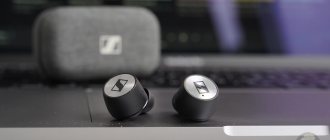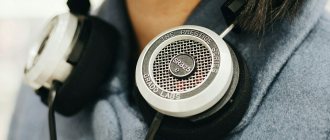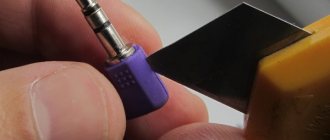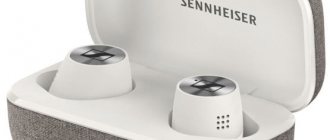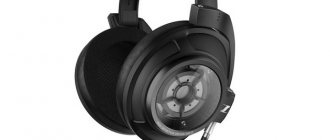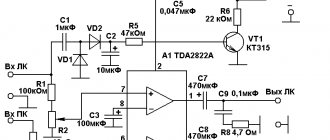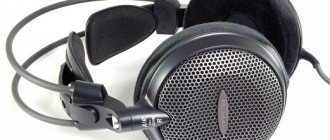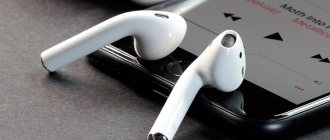Features of operation
Wireless headphones can be divided into:
- headphones;
- infrared;
- Bluetooth headphones, which marketers also call Wi-Fi headphones.
We will tell you about the correct wearing of wireless earbuds, in-ear headphones, and on-ear headphones that support Bluetooth connection.
Earbuds
This type of headphones is called because of the design of the housing. They are inserted into the auricle and are held in place by the elasticity of the tragus and antitragus.
The tragus and antitragus are two small paired cartilaginous projections located in the anterior part of the auricle of the outer human ear.
Wired earbuds are practically no longer used, but wireless ones have gained popularity and began to be copied by manufacturing companies after Apple released its ergonomic AirPods.
The comfort of wearing them depends on the distance between the tragus and the antitragus:
- if it is small compared to the size of the earphone, the person will feel discomfort from wearing it for a long time;
- if it is large, the liner will constantly fall out due to sudden movements of the head.
For music lovers - the sound quality of musical compositions, for those involved in sports - moisture protection.
But the main thing for the user is comfortable placement in the ear tube and wearing the headset.
In-canal
Vacuum or in-ear headphones (plugs, plugs, droplets) acquired their name because they are inserted not into the auricle, but into the ear canal with the help of ear pads.
Selected ear pads, plugging the ear canal like a plug, hold the plugs in the ear well and create additional sound insulation when listening to music tracks in a noisy room.
The auditory canal, located inside the outer ear, is cartilage, has a large diameter at the beginning, tapers and reaches a length of 2 to 3 cm.
It is at its cone-shaped beginning that the embouchure should be tightly inserted.
Vacuum headphones come with several additional pairs of ear pads to help you select the optimal size.
On-ear headset
Over-ear headphones are not inserted into the ears, but are placed on top of them, while the ear pad does not completely cover the auricle, as with full-size ones.
It is attached to the head with various arched headbands or earhooks. And according to the type of sound design, they are divided into open and closed (you can also find a semi-closed version on sale).
Invoices have advantages over liners and plugs:
- better sound quality due to the larger diameter of the dynamic drivers;
- When wearing them, the ears get less tired, since there is no pressure in the auricle, and they do not sweat, like full-size ones.
But there are also disadvantages:
- weight and large dimensions do not allow them to be put into a pocket;
- Some headband designs may put pressure on the back of the head or ears due to the large size of the head.
How to properly put on and wear wireless bluetooth headphones
Manufacturers of Bluetooth headphones took care of wearing comfort by using soft silicone, which ensured a strong attachment to the channel. The first models appeared from Apple, and later such headsets appeared from Xiaomi, Jbl, Honor and others.
Vacuum (plugs)
To prevent the headphones from falling off, they need to be placed correctly:
- Insert into the ears; if the fit is not tight, then pull back the earlobe and push the plug.
- Rotate slightly forward and backward.
- Pull out a little from the ear canal if they are too deep. The depth of immersion is determined depending on the size of the ear pads.
Most models are ergonomically shaped and must be installed correctly for comfortable use. The auricle should touch not only the ear pads, but also the inside of the body. If the steps are performed correctly, the sound will not be muffled and sounds from outside will not be audible. The plugs block noise and are easy to insert. For example, Redmi AirDots fit inside like earplugs.
Inserts (droplets)
Droplets should be inserted like this:
- slightly pull the earlobe forward;
- place the device in your ear;
- lightly press on the body and release the lobe.
The earbuds are fixed due to the fact that the ear canal compresses the tablet. For TWS Aceline, Bron, Dexp headphone models, the recommendations are different. In them, the tail should not be set aside, but placed close to the skin. For those who frequently lose their headsets, there are cords that hold the headphones together, but this defeats the purpose of the design. Popular earbuds from Honor, Airpods, Huawei, Smartbuy, TFN.
The best bluetooth headphones in ear
Invoices
You need to use overhead products like this:
- Connect to audio device. The plug must fit tightly into the connector; if not, the headset is not compatible with the device. Wireless connect via bluetooth.
- Should be worn in accordance with the “L” and “R” markings found on most models. If there is no mark, you can wear it however you like.
- Place the headphones on your head. It is important that the headband fits snugly to your head and that it is adjusted to fit.
- Place the cups over your ears. The cups should fit snugly to the ear. Closed and voluminous in-ear devices fit snugly into the ear and cancel out external noise. Open models have a pad that fits the size of the auricle, so it should be placed above the ear canal.
Users prefer sports headphone models from Jibiel, Philips, and Samsung. They have a slightly bent wire at the base. It is placed behind the ear like glasses. Sports models are worn not from below, but from above, carrying the cable over the sink, which avoids falling out during running and other workouts.
How to wear?
To avoid injury, before properly putting on any type of headphones, it is advisable to remove all jewelry from your ears.
If the correct use of the on-ear headset does not cause problems (it is enough to place the headband in the middle of the head).
The comfort of wearing earbuds and plugs does not depend on the design and size, but on how correctly they are inserted into the ear.
How to wear earbuds?
The question of how to put on headphones correctly may seem funny and strange, but can you be sure that you are doing it correctly?
Most often, the equipment comes with instructions for use, but this is of little interest to buyers of “droplets”, because nothing can go wrong. This kind of thinking leads to devices falling out of their ears, causing inconvenience, and buyers scolding innocent technology, although they themselves have not figured out how to use it.
In general, the correct way to put on headphones is as follows:
- Place the earphone in your ear and press the earbud against your ear canal.
- Press down on the earpiece so that the silicone component is partially inserted into the passage.
- If you feel that the device is not sitting tightly, pull back your earlobe slightly, thereby widening the ear canal.
- Push the earphone a little deeper into your ear and release the earlobe.
Make sure that you are comfortable, but that the silicone ear tip does not go completely into your ear. If this happens, pull the device out of the canal slightly. A stuck earbud is very difficult to get out without medical help, so it’s better not to let it get to that point.
How to insert correctly?
Proper wearing of earbuds can be seen using the ergonomic AirPods model as an example.
This is done in the following order:
- by the letter printed on the stem “R” or “L”, they determine which ear each earphone should be inserted into;
- carefully install the earbuds into the auricle;
- holding the stem of each of the headphones, rotate them 30° forward and backward until they take the most comfortable, correct position in the ear.
To properly insert a vacuum plug into your ear, you must:
- bring the earphone to the ear canal and, gently pushing it with your finger, fix it in the ear;
- With the opposite hand, pull back the earlobe, insert the plug until the ear pad sits tightly inside the ear canal;
- release the earlobe, and the auricle will take a natural position and fix the earphone.
The fact that the headset is inserted correctly inside the ear will be indicated by an improvement in sound, and with vacuum earplugs there is also a sharp decrease in external noise.
How to wear safely outside?
To ensure safe wearing of headphones outside the home, follow the rules below.
How to choose and wear in-ear headphones correctly
I love listening to music on in-ear headphones. The sound is rich and completely natural, they block out external sounds, are very lightweight and portable. I often recommend them to friends when they ask me which headphones they should buy.
But also often friends come back and say that they are unhappy with the sound. They sound like a tin can. Lacks bass. They fall out too often. But in fact, their problem seems to lie not in the functioning of the headphones, but in the correct selection of them.
In-ear headphones look like earplugs, but they work on a different principle. They don't hang on your ears like traditional headphones, but are designed to be worn fully inserted into your ears. This should be done in such a way that the soft tip forms an airtight seal with the walls of the ear canal - like a cork in a bottle of wine. If there is no such seal, sound transmission will deteriorate (especially low frequencies) and you will hear too much extraneous noise.
You don't just have to put them in your ears. You have to do it right.
Here's the correct way:
Start by placing the headphones in your ears and push them a little deeper. Then use both hands to position the headphones correctly. In the case of the left ear, use your right hand to grab your left earlobe. Pull the earlobe down a little to widen the ear canal. Then use your left index finger to gently push the earbud further. Not to the eardrum, of course, but far enough so that you feel the resistance. Release your earlobe. Your ear canal will return to its normal size and you will feel some firmness in your ear. Now do the same for the other ear.
You will notice that the sound coming from the headphones is louder (turn down the volume a little) and that the bass is much better heard. Extraneous noise has disappeared. Some people don't like this - they get claustrophobic, but without too much noise the music sounds more exciting. Learn to enjoy being alone.
In order for sound insulation to be complete, it is necessary to select the correct size of the nozzle. Most often, headphones come with several tips of different sizes, made of different materials, such as rubber and foam. Start with the smallest size. If it is small, move towards a larger size. Try the largest size last - you will be surprised, but a smaller tip size sometimes gives better results. If you are not satisfied with the rubber tips, try different foams. Most manufacturers make excellent foam tips for different types of in-ear headphones.
Vacuum
Passive noise cancellation makes vacuum headphones the most dangerous to wear outdoors.
When approaching a pedestrian crossing, you need to pause the playback, or better yet, remove the ear plugs.
It is better to avoid listening to music tracks while riding a bicycle on roads.
Tips for wearing outdoors
According to statistics, headphones are most often used outside the home, including on public transport. This places some responsibility on the owners. First of all, we are talking about participation in road traffic. Several years ago, the Russian government submitted a bill to introduce fines for wearing headphones by cyclists and pedestrians who cross the roadway. This is due to an increase in the number of accidents caused by inattentive music lovers. Despite the fact that the law was not adopted, certain conclusions follow from this situation.
Important! You should cross the road very carefully, regardless of whether music is playing in the speakers. And while riding a bicycle, it is better to refrain from listening altogether in order to be able to fully assess the road situation, and not just the picture before your eyes.
However, the street is not only society, but also natural factors. It should be remembered that when exposed to low temperatures, wire windings are prone to hardening and cracking. Therefore, before leaving the room, you should hide and carry all the wiring under your clothes. We should not forget about careful handling of the headset while walking.
Advice! To prevent the headphones from getting tangled, it is recommended to get a special case. Those who like to walk with a backpack on their shoulders will appreciate models with a built-in USB connector or at least a hole for headphones.
Wireless earbuds
When going outside, you need to make sure that you are wearing the earbuds of truly wireless headphones correctly in your ears, since if you lose them it will be difficult to find them.
Losing the headset can be caused by active jaw movement during a telephone conversation or when chewing food while listening to a track.
To prevent them from falling out of your ears, it is correct to wear headphones in winter, preferably under a hat, since low temperatures make the plastic housing of the headphones brittle.
Silicone pads
For a more secure fit in the ear, you can use silicone pads. They have an anti-slip effect. With them, headphones do not fly out of your ears. This will be useful when running or other active sports. Yes, and just when walking.
They also have a noise-absorbing effect. Silicone pads are available for headphones from different companies, in different colors.
View price on Aliexpress
Invoices
Proper wearing of on-ear headphones outdoors is considered the safest.
They cannot be lost, and due to the audibility of external sounds, the user can react to approaching danger.
However, it is inconvenient to engage in active sports (even just jogging) with such headphones, and they will not fit with a business suit.
The sound of on-ear headphones, especially the open type, is audible not only to the user, but also to those around him.
Therefore, when wearing in places where people come to take a break from city noise, you should reduce the volume to a minimum or turn it off.
If the user is in a deserted place, in order for the ears to rest, the headset should be hung correctly on the neck, making the sound louder.
In winter, on-ear headphones are correctly and conveniently worn over knitted hats, and the sound quality is minimally reduced.
In late autumn or early spring, a knitted hat can be replaced with this gadget with fur ear pads on.
How to wear headphones outdoors?
Let's look at ways to wear headphones depending on their form factor. Let's distinguish two large groups of devices: large (studio, overhead) and small (vacuum, in-ear) in order to determine the rules for each of them separately.
Small headphones
Small headphones, which include in-ear and vacuum models, fit in the ear without any problems and do not take up much space, so often problems when wearing them arise only with the wire - it constantly clings to clothes, foreign objects, etc. How to solve this problem? Let's consider several ways:
- A long cord always creates inconvenience for the user, so it should be shortened. To do this, you don't need to cut anything, you just need to wrap one earphone around your neck and only then insert it into your ear. This way you can easily and quickly solve the problem.
- This method is only suitable for cold seasons when you are wearing a jacket or other outerwear. The always-in-the-way cord can be easily hidden under clothing, and then it will not cling to surrounding objects.
- If the model of vacuum headphones allows, it is recommended to insert them into the ear canal, and throw the wire behind the ear. This technique will prevent the earphone from falling out of your ear if the wire is accidentally touched or pulled.
- Manufacturers are also concerned about users, so most headphones have special clothespins that allow you to attach the wire to items of clothing.
The problem with the long wire is solved, but what to do if you have large headphones?
Big headphones
Many people choose on-ear or studio headphones, justifying this by the fact that they convey better sound quality and do not have such a strong impact on hearing. In turn, wearing such an accessory also creates minor problems for the user. Let's sort them out.
- Large headphones are especially uncomfortable when worn with a hat. But there is also a solution to this. For example, if the headdress sticks out upward, the headphone bar can be lowered to the back of the neck. The sound will not lose volume. The headphones themselves can easily be worn over a hat.
- If you feel uncomfortable wearing headphones with a hat, then the device can be used without a hat. It will keep your ears warm, but the rest of your head may get cold.
Rules for choosing diameter and shape
When purchasing wireless headphones, the user must take into account not only the popularity of the gadget, but also that the design features of the headset are suitable for his ear shape.
After all, sound quality, design, and other positive features (active noise cancellation, water protection) will be minimized if the user finds it painful to wear the purchased headphones.
The right size and material will make the headset easier to wear
Some plastics or other materials used in headphones or ear pads may cause an allergic reaction.
Finding the right size of headphones is difficult for people with both large and small ears, and this does not depend on the gender of the user.
Therefore, foam tips are made for earbuds, and ear pads for vacuum headphones are produced not only in different sizes, shapes, with a rounded end and a conical one.
On sale you can find tips for plugs in the shape of a herringbone and even in the form of earplugs made of special foam material and attached behind the ear (hook).
If the selected headphones cause pain from wearing for a long time, you should not be upset right away.
It is worth trying to choose suitable ear pads or a hook, even taking into account the fact that the user has ears of different sizes.
How to choose an ear pad and the shape of the earbuds individually?
For reliable fixation in the ear canal and expansion of the ear canal, earplug headsets are equipped with soft ear pads. They are located on the edge of the tube body through which sound passes. In order not to feel discomfort, you need to choose the correct diameter of the thickening of the ear pads and know how to wear in-ear headphones correctly.
Ear pads are divided into types according to size (edge diameter - thickening):
- 5mm-7mm. Suitable for children, girls, short people. In addition to the above categories, this size is suitable for people with anatomically small ears;
- 5mm-9mm. For people of tall and average height;
- 5mm-11mm. Rarely found in practice.
The diameter is the same for all types; they are guided by the thickness of the expansion. The material from which the ear pads are made also matters. The softer it is, the more comfortable it is for the ear. Silicone comes first. They are easy to clean (hygiene is important) and do not deform at sub-zero temperatures. The thinner the diameter of the extension, the easier it is to install the plug in the ear, but the less sound insulation will be. Over time, the material gets crushed and the headset may fall out. Then the silicone pads are replaced with new ones.
Rules for choosing a headphone shape:
- straight. The shape leads to fatigue of the shell and numbness of the contact points. Straight-shaped vacuum sound conductors are difficult to insert correctly into the ear canal;
- curved. More comfortable on the ear as the body has a slight curve for a snug fit.
If the headset falls out
The headset may fall out of the ear when worn:
- The ear pads of the plugs are not selected correctly or have changed their shape and density due to long wearing. Then you should replace them with others that are available as standard, or select them separately in the store.
- The earbuds do not stay inside the ears due to the large distance between the tragus and antitragus. Buy special attachments with a hook and lock for this model of headphones.
- Plugs or earbuds fall out due to large dimensions (several speakers are built-in) or weight. The headset simply does not fit the ears; if this is noticed in time, it is advisable to immediately take them to the store.
What to do if the headphones fall out of your ear
If vacuum headphones fall out of your ear, the reason is often due to a discrepancy between the size of the ear pads and the diameter of the ear canal. Therefore, first of all, they check whether the kit includes a set of “pads” and select the appropriate ones. In addition, if in the previous headset the user used the average size of ear pads, then it is not a fact that in the new headphones their size will coincide with the previous one.
If you still have old in-ear headphones, you can use ear pads from them, because... For most manufacturers, the sound guide has similar dimensions. If you don't have spare ear pads, you can buy them separately. They are produced not only from different materials, but also have different densities. Foam ear pads are a universal option, because... They conform to the shape of the ear canal and fit comfortably.
The earbuds may fall out due to their poor placement in the ear opening. To ensure the headset fits correctly, you should press the protrusion of your ear and tilt it forward. Then insert the earbud into your ear at a right angle and press it. When performing this action, strong and sudden movements are unacceptable.
If the earbuds fall out of your ears, to securely fasten them, the wire is placed behind your ear. This method works provided the earphone has a suitable shape and is connected to wired accessories. A wire holder may also help. It is attached to the temple using adhesive tape or other material. Similar mounts are sold on Aliexpress. But again, this method is suitable for listening to audio at home. Whereas on the street it looks doubtful.
Incorrect wearing
So, wearing a wireless headset incorrectly can lead to consequences that are dangerous to the user’s health:
- Long-term listening to music at maximum volume can lead to hearing loss - permanent hearing loss, unclear perception of the sounds of the outside world, and, consequently, disruption of speech communication.
- The parallel perception of external sound and tracks coming from headphones during the day can lead to increased fatigue, migraines, and chronic fatigue syndrome.
- When listening for a long time in a vacuum headset, the earwax may thicken, which leads to the formation of cerumen plugs and hearing impairment.
- To avoid infection with infectious diseases, the headset should not be shared with others. When you come home from the street, you need to wipe them with alcohol-soaked wipes.
- The user needs to change the ear pads regularly.
- If the vacuum earphone is removed incorrectly from the auricle, the ear pad may remain inside the ear canal, and it will be difficult to remove it painlessly.
Due to listening to loud music, cyclists and pedestrians do not hear danger signals and become the cause of road accidents.
